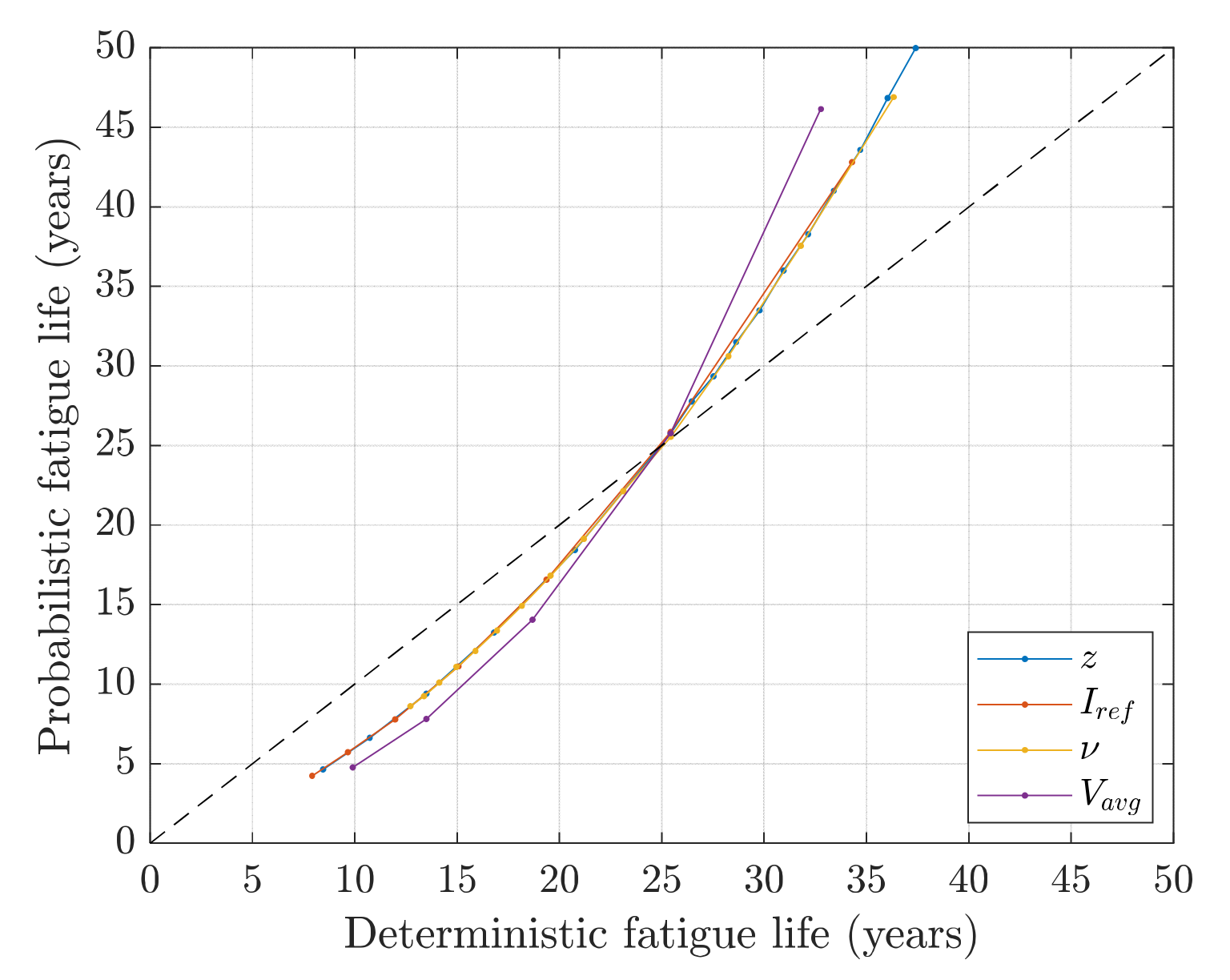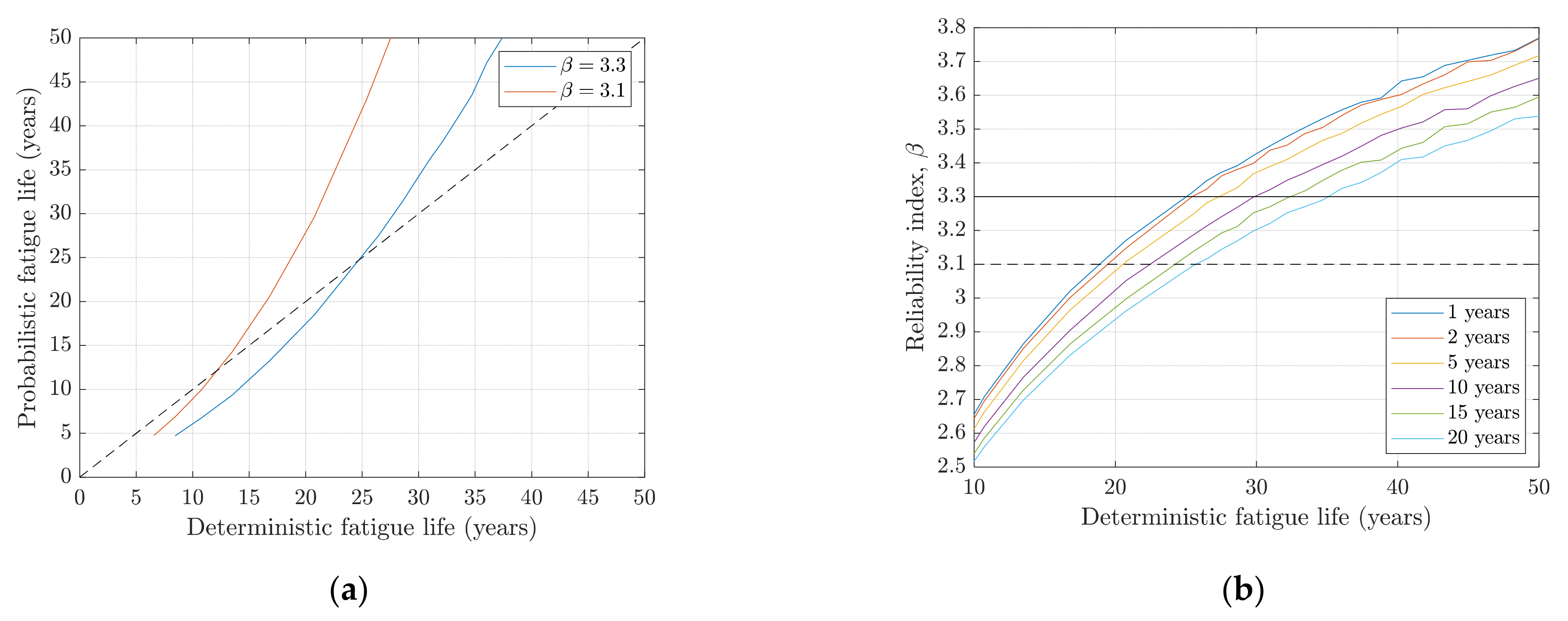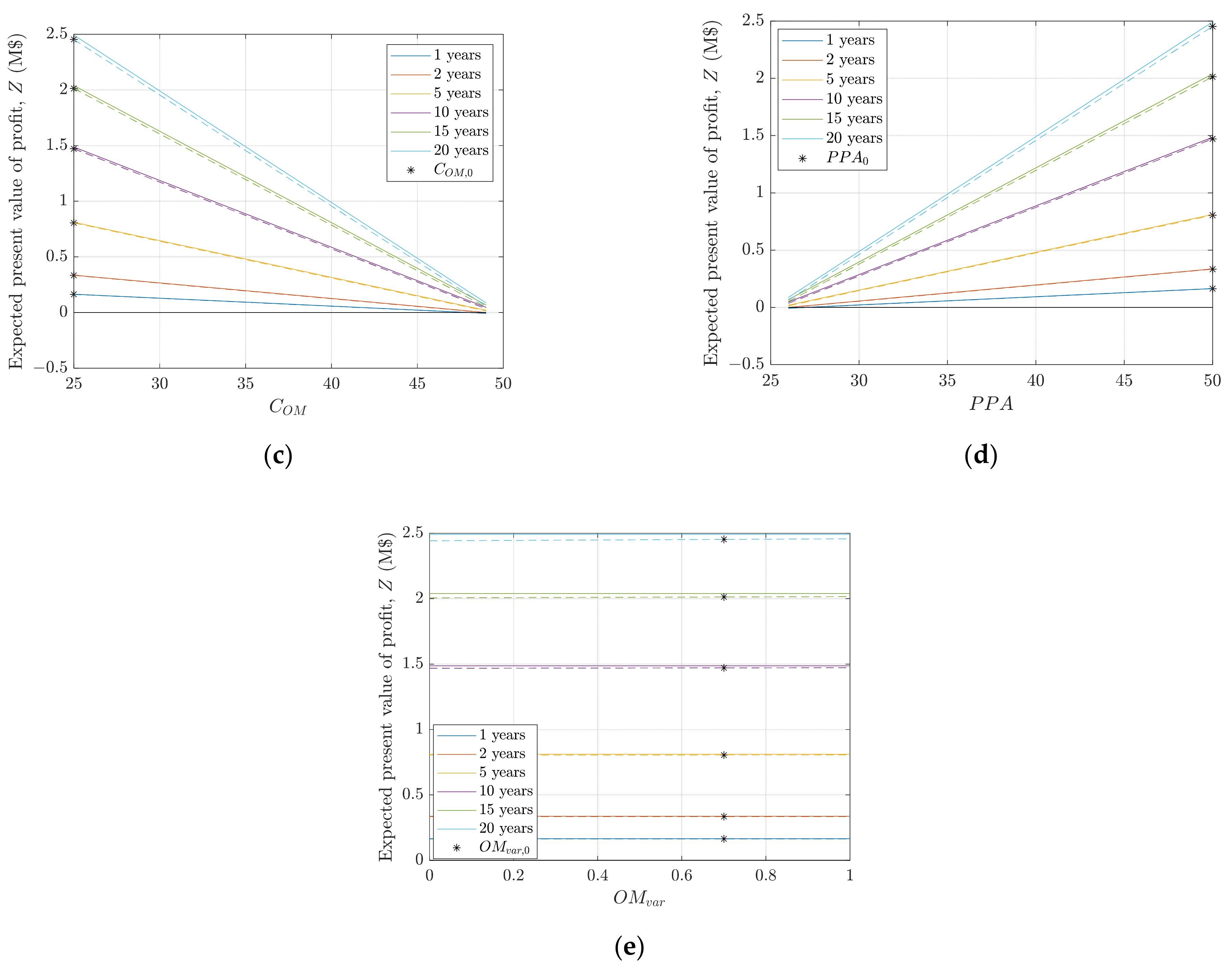Probabilistic and Risk-Informed Life Extension Assessment of Wind Turbine Structural Components
Abstract
:1. Introduction
2. Background
2.1. Deterministic/Semi-Probabilistic Assessment
- is the number of load cycles per year.
- is the time in years.
- is the partial safety factor on the load effect (stress cycles).
- and are SN curve slopes.
- and are the characteristic values of the SN curve intercept parameters.
- and are the mean values of for each part of the SN curve divided by the proportion of cycles on the respective parts of the curve.
- is a design parameter (proportional to a cross-sectional parameter).
2.2. Probabilistic Assessment
- is the model uncertainty related to the use of Miner’s rule for damage accumulation, modeled by a normally distributed variable with mean value one and coefficient of variation .
- is the model uncertainty of the load effect modeled by a lognormal variable with mean value one and coefficient of variation .
- and are SN curve intercept parameters; and are modeled by normally-distributed, fully-correlated stochastic variables with standard deviations .
2.3. Risk-Informed Assessment
- : benefit (income from power production).
- : life extension cost.
- : variable O&M costs.
- : fixed O&M costs.
- : cost of structural failure.
3. Case Study
3.1. Case Wind Farm
- Visual inspection: .
- Loads analysis: .
- Operations analysis: .
- No repairs: .
- Low level: 10,000,000 (50% of gearboxes).
- Medium level: 17,500,000 (50% of the blades).
- High level: 25,000,000 (40% each of blades, gearboxes, and generators).
3.2. Procedure
3.2.1. Deterministic Assessment
3.2.2. Probabilistic Assessment
3.2.3. Risk-Informed Assessment
4. Results
4.1. Deterministic Assessment
4.2. Probabilistic Assessment
4.3. Risk-Based Assessment
5. Discussion
6. Conclusions
Author Contributions
Funding
Institutional Review Board Statement
Informed Consent Statement
Data Availability Statement
Conflicts of Interest
References
- Ziegler, L.; Gonzalez, E.; Rubert, T.; Smolka, U.; Melero, J.J. Lifetime extension of onshore wind turbines: A review covering Germany, Spain, Denmark, and the UK. Renew. Sustain. Energy Rev. 2018, 82, 1261–1271. [Google Scholar] [CrossRef] [Green Version]
- Luengo, M.; Kolios, A. Failure Mode Identification and End of Life Scenarios of Offshore Wind Turbines: A Review. Energies 2015, 8, 8339–8354. [Google Scholar] [CrossRef] [Green Version]
- DNVGL-ST-0262 Lifetime Extension of Wind Turbines; DNV GL: Oslo, Norway, 2016.
- DNVGL-SE-0263 Certification of Lifetime Extension of Wind Turbines; DNV GL: Oslo, Norway, 2016.
- Ziegler, L.; Muskulus, M. Fatigue reassessment for lifetime extension of offshore wind monopile substructures. J. Phys. Conf. Ser. 2016, 753, 092010. [Google Scholar] [CrossRef]
- Bouty, C.; Schafhirt, S.; Ziegler, L. Lifetime extension for large offshore wind farms: Is it enough to reassess fatigue for selected design positions? Energy Procedia 2017, 137, 523–530. [Google Scholar] [CrossRef]
- Murcia, J.P.; Réthoré, P.-E.E.; Dimitrov, N.; Natarajan, A.; Sørensen, J.D.; Graf, P.; Kim, T. Uncertainty propagation through an aeroelastic wind turbine model using polynomial surrogates. Renew. Energy 2018, 119, 910–922. [Google Scholar] [CrossRef] [Green Version]
- Slot, R.M.M.; Sørensen, J.D.; Sudret, B.; Svenningsen, L.; Thøgersen, M.L. Surrogate model uncertainty in wind turbine reliability assessment. Renew. Energy 2019. [Google Scholar] [CrossRef] [Green Version]
- Schröder, L.; Dimitrov, N.K.; Verelst, D.R.; Sorensen, J.A. Wind turbine site-specific load estimation using artificial neural networks calibrated by means of high-fidelity load simulations. J. Phys. Conf. Ser. 2018, 1037, 062027. [Google Scholar] [CrossRef]
- Dimitrov, N. Surrogate models for parameterized representation of wake-induced loads in wind farms. Wind Energy 2019, 22, 1371–1389. [Google Scholar] [CrossRef]
- Dimitrov, N.; Natarajan, A. From SCADA to lifetime assessment and performance optimization: How to use models and machine learning to extract useful insights from limited data. J. Phys. Conf. Ser. 2019, 1222, 012032. [Google Scholar] [CrossRef]
- Natarajan, A.; Dimitrov, N.K.; William Peter, D.R.; Bergami, L.; Madsen, J.; Olesen, N.; Krogh, T.; Nielsen, J.S.; Sørensen, J.D.; Pedersen, M.; et al. Demonstration of Requirements for Life Extension of Wind Turbines Beyond Their Design Life (LifeWind): Project Final Report; No. E-0196; DTU Wind Energy: Roskilde, Denmark, 2020. [Google Scholar]
- Kazemi Amiri, A.; Kazacoks, R.; McMillan, D.; Feuchtwang, J.; Leithead, W. Farm-wide assessment of wind turbine lifetime extension using detailed tower model and actual operational history. J. Phys. Conf. Ser. 2019, 1222, 012034. [Google Scholar] [CrossRef]
- Slot, R.M.M.; Schwarte, J.; Svenningsen, L.; Sørensen, J.D.; Thøgersen, M.L. Directional fatigue accumulation in wind turbine steel towers. J. Phys. Conf. Ser. 2018, 1102, 012017. [Google Scholar] [CrossRef]
- Colone, L.; Natarajan, A.; Dimitrov, N. Impact of turbulence induced loads and wave kinematic models on fatigue reliability estimates of offshore wind turbine monopiles. Ocean Eng. 2018, 155, 295–309. [Google Scholar] [CrossRef]
- Ziegler, L.; Cosack, N.; Kolios, A.; Muskulus, M. Structural monitoring for lifetime extension of offshore wind monopiles: Verification of strain-based load extrapolation algorithm. Mar. Struct. 2019, 66, 154–163. [Google Scholar] [CrossRef]
- Smith, J.C.; Carriveau, R.; Ting, D.S.K. Inflow parameter effects on wind turbine tower cyclic loading. Wind Eng. 2014, 38, 477–488. [Google Scholar] [CrossRef]
- Mai, Q.A.; Weijtjens, W.; Devriendt, C.; Morato, P.G.; Rigo, P.; Sørensen, J.D. Prediction of remaining fatigue life of welded joints in wind turbine support structures considering strain measurement and a joint distribution of oceanographic data. Mar. Struct. 2019, 66, 307–322. [Google Scholar] [CrossRef]
- Natarajan, A.; Pedersen, T.F. Remaining Life Assessment of Offshore Wind Turbines subject to Curtailment. In Proceedings of the Twenty-Eighth (2018) International Ocean and Polar Engineering Conference, International Society of Offshore & Polar Engineers, Sapporo, Japan, 10–15 June 2018; pp. 527–532. [Google Scholar]
- Ilsted Bech, J.; Bay Hasager, C.; Bak, C. Extending the life of wind turbine blade leading edges by reducing the tip speed during extreme precipitation events. Wind Energy Sci. 2018, 3, 729–748. [Google Scholar] [CrossRef] [Green Version]
- Rubert, T.; McMillan, D.; Niewczas, P. A decision support tool to assist with lifetime extension of wind turbines. Renew. Energy 2018. [Google Scholar] [CrossRef] [Green Version]
- Carriveau, R.; Miller, L. Economic Sensitivities and Options Surrounding Wind Farm Life Extension. J. Phys. Conf. Ser. 2020, 1452, 012047. [Google Scholar] [CrossRef] [Green Version]
- Rubert, T.; McMillan, D.; Niewczas, P. The Effect of Upscaling and Performance Degradation on Onshore Wind Turbine Lifetime Extension Decision Making. J. Phys. Conf. Ser. 2017, 926, 012013. [Google Scholar] [CrossRef]
- Ziegler, L.; Lange, J.; Smolka, U.; Muskulus, M. The decision on the time to switch from lifetime extension to repowering. In Proceedings of the WindEurope Summit 2016, Hamburg, Germany, 27–29 September 2016. [Google Scholar]
- Rubert, T.; Zorzi, G.; Fusiek, G.; Niewczas, P.; McMillan, D.; McAlorum, J.; Perry, M. Wind turbine lifetime extension decision-making based on structural health monitoring. Renew. Energy 2019. [Google Scholar] [CrossRef]
- Nielsen, J.S.; Sørensen, J.D. Bayesian Estimation of Remaining Useful Life for Wind Turbine Blades. Energies 2017, 10, 664. [Google Scholar] [CrossRef] [Green Version]
- Nielsen, J.S.; Tcherniak, D.; Ulriksen, M.D. A case study on risk-based maintenance of wind turbine blades with structural health monitoring. Struct. Infrastruct. Eng. 2020. accepted. [Google Scholar] [CrossRef]
- IEC 61400-1 ed. 4 Wind Turbine Generator Systems-Part 1: Design Requirements; International Electrotechnical Commission: Geneva, Switzerland, 2019.
- Sørensen, J.D.; Toft, H.S. Safety Factors–IEC 61400-1 ed.; 4-Background Document, DTU Wind Energy-E-Report-0066(EN); DTU: Copenhagen, Denmark, 2014. [Google Scholar]
- Sørensen, J.D. Reliability assessment of wind turbines. In Safety, Reliability and Risk Analysis: Beyond the Horizon-Proceedings of the European Safety and Reliability Conference, ESREL 2013, Amsterdam, The Netherlands, 29 September–2 October 2013; Steenbergen, R.D.J.M., van Gelder, P.H.A.J.M., Miraglia, S., Vrouwenvelder, A.C.W.M., Eds.; CRC Press: Boca Raton, FL, USA, 2014. [Google Scholar]
- Sørensen, J.D.; Frandsen, S.; Tarp-Johansen, N.J. Effective turbulence models and fatigue reliability in wind farms. Probab. Eng. Mech. 2008, 23, 531–538. [Google Scholar] [CrossRef]
- ISO2394 General Principles on Reliability for Structures; International Organization for Standardization: Geneva, Switzerland, 2015.
- Rackwitz, R. Optimization—The basis of code-making and reliability verification. Struct. Saf. 2000, 22, 27–60. [Google Scholar] [CrossRef]
- Fischer, K.; Viljoen, C.; Köhler, J.; Faber, M.H. Optimal and acceptable reliabilities for structural design. Struct. Saf. 2019, 76, 149–161. [Google Scholar] [CrossRef]
- Nielsen, J.S.; Dimitrov, N.K.; Sørensen, J.D. Optimal decision making for life extension for wind turbines. In Proceedings of the 13th International Conference on Applications of Statistics and Probability in Civil Engineering, ICASP 2019, Seoul, Korea, 26–30 May 2019. [Google Scholar]
- Nielsen, J.S.; Sørensen, J.D. Risk-based derivation of target reliability levels for life extension of wind turbine structural components. Wind Energy 2021, 1–18. [Google Scholar] [CrossRef]
- Rubert, T.; Niewczas, P.; McMillan, D. Life Extension for Wind Turbine Structures and Foundations. In Proceedings of the International Conference on Offshore Renewable Energy, Glasgow, Scotland, UK, 12–14 September 2016; pp. 1–12. [Google Scholar]








| Analysis Method | Remaining Fatigue Life/Life Extension Period (Years) | Expected Present Value of Profit (M$) | |||
|---|---|---|---|---|---|
| No Repairs | Low Level | Medium Level | High Level | ||
| Deterministic | 1 | 0.165 | −0.063 | −0.233 | −0.404 |
| Prob. | 1.8 | 0.300 | 0.072 | −0.098 | −0.268 |
| Prob. | >20.0 | 2.492 | 2.264 | 2.094 | 1.923 |
| Deterministic | 2 | 0.336 | 0.109 | −0.062 | −0.232 |
| Prob. | 3.5 | 0.574 | 0.347 | 0.177 | 0.006 |
| Prob. | >20.0 | 2.492 | 2.264 | 2.094 | 1.923 |
| Deterministic | 5 | 0.811 | 0.584 | 0.413 | 0.243 |
| Prob. | 9.2 | 1.381 | 1.154 | 0.984 | 0.813 |
| Prob. | >20.0 | 2.492 | 2.264 | 2.094 | 1.923 |
| Deterministic | 10 | 1.486 | 1.259 | 1.088 | 0.918 |
| Prob. | 19.3 | 2.431 | 2.204 | 2.034 | 1.863 |
| Prob. | >20.0 | 2.492 | 2.264 | 2.094 | 1.923 |
| Deterministic | 15 | 2.039 | 1.812 | 1.641 | 1.471 |
| Prob. | >20.0 | 2.492 | 2.264 | 2.094 | 1.923 |
| Prob. | >20.0 | 2.492 | 2.264 | 2.094 | 1.923 |
| Deterministic | 20 | 2.492 | 2.264 | 2.094 | 1.923 |
| Prob. | >20.0 | 2.492 | 2.264 | 2.094 | 1.923 |
| Prob. | >20.0 | 2.492 | 2.264 | 2.094 | 1.923 |
Publisher’s Note: MDPI stays neutral with regard to jurisdictional claims in published maps and institutional affiliations. |
© 2021 by the authors. Licensee MDPI, Basel, Switzerland. This article is an open access article distributed under the terms and conditions of the Creative Commons Attribution (CC BY) license (http://creativecommons.org/licenses/by/4.0/).
Share and Cite
Nielsen, J.S.; Miller-Branovacki, L.; Carriveau, R. Probabilistic and Risk-Informed Life Extension Assessment of Wind Turbine Structural Components. Energies 2021, 14, 821. https://doi.org/10.3390/en14040821
Nielsen JS, Miller-Branovacki L, Carriveau R. Probabilistic and Risk-Informed Life Extension Assessment of Wind Turbine Structural Components. Energies. 2021; 14(4):821. https://doi.org/10.3390/en14040821
Chicago/Turabian StyleNielsen, Jannie Sønderkær, Lindsay Miller-Branovacki, and Rupp Carriveau. 2021. "Probabilistic and Risk-Informed Life Extension Assessment of Wind Turbine Structural Components" Energies 14, no. 4: 821. https://doi.org/10.3390/en14040821






